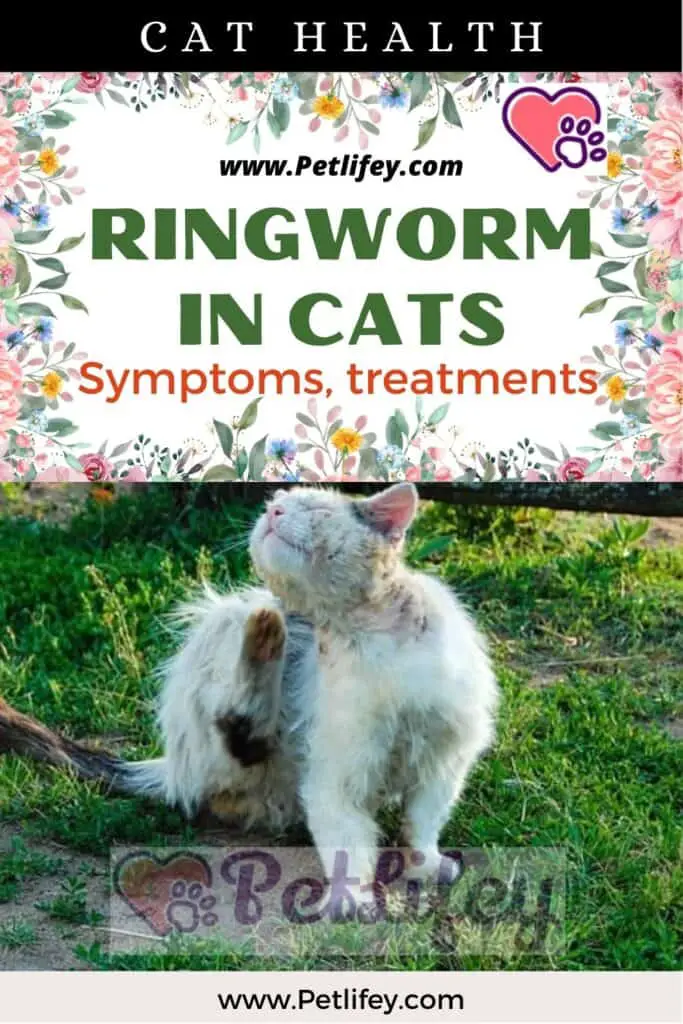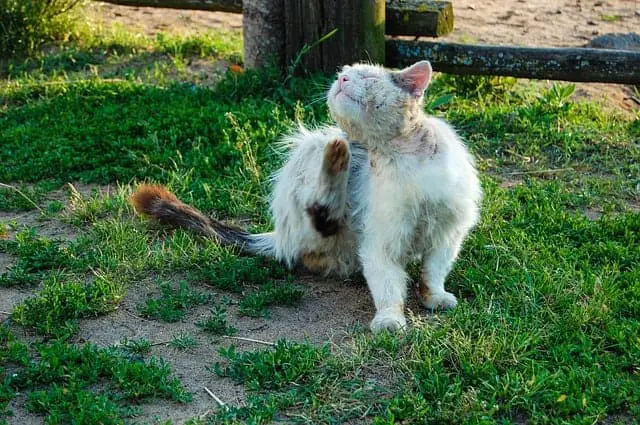
We are going to talk about ringworm in cats and it is that when we make the decision to have a cat, as part of the family, we must also ensure its health and well-being.
Our cats often suffer from different health problems, since they are animals, which have a coat that requires a lot of care. Among one of these problems is ringworm in cats or Dermatophytosis, which is a disease caused by a fungus called Microspurun canis (M.canis).
The cats that generally acquire this disease are small cats with a weak immune system, weak cats due to old age or some chronic pathology. It is highly contagious with other species including humans.
When our cat’s skin is healthy, without autotrauma, it can rarely be infected with ringworm, so we must bear in mind that a cat without fleas, lice and parasites that damage the skin, is almost certainly a cat without ringworm. So that you are not surprised by the situation and without knowledge about the subject of ringworm, below we are going to know everything about it, how it is spread, what are the symptoms of ringworm in cats and treatment to treat this pathology.
How to know if a cat has ringworm?
When a cat has ringworm, the symptoms are very varied, since to a large extent it will depend on the integral health of the same, because the disease can present with severe or mild lesions, they can be circular and alopecic, on the head, legs and ears.
The skin flakes and gives the impression of being inflamed, the hairs that surround the area may be split, sometimes cats only have their nails affected, if you observe the broken and brittle veins.
As well as you will see areas without fur, since the fungus cannot live in areas with hair, you should also observe if it frequently scratches, bites or licks a specific area, as well as emit a different smell in the affected area.
How a vet confirms what ringworm is in cats
Diagnosing ringworm in cats is not enough with a clinical review, since it can be confused with other skin conditions, so the veterinarian must perform at least 2 of the existing tests to diagnose this disease:
- Wood’s ultraviolet lamp: it is a test that is not 100% effective in detecting the disease, because it is done in a dark room and the light is directed towards the infected hairs, showing a fluorescence light of green apple color, by a metabolite that produces the M canis, but not all species show this efflorescence, which is why the result is not effective, but nevertheless, hair samples can be taken for another examination.
- Microscopic examination of suspicious hairs: this examination must be carried out by an expert mycologist, it is unreliable and quick if fungal elements are found, if not, it may be that the sample was taken incorrectly.
- The fungal culture: this test is performed by selecting the broken hairs that are around the lesions, in case the cat does not have lesions, a sterile toothbrush should be taken, brushed and samples taken, then in the laboratory, Everything concerning the cultivation will be carried out , for a truthful result.
Ringworm in cats and treatments
If the cat is healthy and strong, the organism self-eliminates in a week through the defences, if on the contrary it has low defences it is necessary to provide treatment for ringworm in cats, to eliminate the infection, and prevent it from spreading between other animals and humans, so you must attack immediately.
Systemic therapy
You must take medicine for three weeks with an intermediate rest week between each one, together with a topical application in the affected areas, the treatment must be done constantly, respecting the rest week for its effectiveness,
There are a variety of medications for this disease such as: Itrafungol syrup that contains Itraconazole.
It can be used in cats from 10 days of age, caution must be exercised in case of pregnancy.
We also have Terbifine, it is an expensive drug, but very effective, Lefenuron, which is also an flea killer, works by eliminating the production of chitin, since M canis fungi have a chitin wall .
Topical therapy
This is done with shampoo or rinse, all over the body, it is like bathing the cat, but it must be left for 10 minutes and gently massaged with the fingertips, all over the body, it is a procedure that must be performed two times per week.
With topical therapy we reduce environmental pollution, it is important to cut the hair or shave the cat before applying the treatment .
If you decide to shave, it is better to do it with the cat sedated, thus avoiding doing more damage to the lesions and spreading them, burning the cut and / or shaved hairs and disinfecting the blades.
It is also important to re-shave cats weeks after starting systemic treatment, as the medication takes effect and new uncontaminated hair begins to emerge.
Among the topical therapy medications we have: Malaseb shampoo;
Enilconazole rinse, has been found to be a bit toxic, so it is recommended to use a cone, until it dries.
If there are other cats or dogs, you should also carry out the tests and apply treatment to all of them.
Time and stages to cure ringworm in cats
The time to cure ringworm in cats will depend on how the treatment is applied, since if it is done properly and in the established times respecting the rest week it should be in 6 or 7 weeks.
If you have more than one animal, be it cats or dogs, this healing time will be longer, and everything will also depend on how your cat’s infection is and we have three stages:
Simple condition:
With a cat in good health, with visible lesions, it will quickly and safely respond to treatment in a short period of time.
Infection with complications:
A long-haired, thick-haired cat with larger lesions, presenting various pathologies, will not respond to treatment as easily, it will take longer to heal completely, and it will have greater resistance to medications.
Positive fungal culture No lesions:
These are cats with a very strong immune system, who have had contact with infected cats, do not show symptoms, but nevertheless transmit infectious spores, which are found in their hairs.
Therefore, topical treatment should also be applied to them, they will correspond very well and in a short period of time.
Everything that the cats have had contact with must be eliminated (collar, basket, bed, cloth toys), combs and brushes that cannot be disinfected, they must be burned.
They should be kept in one area with nothing, just a cardboard box that can be changed weekly, for the duration of treatment and illness.
All areas must be thoroughly cleaned, with bleach, daily, if you have fans, heating and air conditioning, the vacuum bag must be vacuumed, cleaned and burned in order to kill spores from contaminated hairs.
Ringworm Prevention in Cats
To prevent ringworm in cats we must take into account health and the environment, starting with food.
A poorly fed cat is potentially sensitive to parasites and a low defense system, lack of hygiene, excess humidity or heat and stress can affect our feline and acquire this M. canis fungus.
So we must pay more attention, help them groom themselves if they are cats with very long hair or if they have arthritis problems, be aware of the sites they visit.
Even if they do not have the disease, bathing them with a fungicide would not hurt, as a way of prevention every 6 months , keep their areas disinfected and clean.
Is ringworm in cats contagious in humans?

Ringworm or dermatophytosis is a zoonosis disease and it can be spread to humans, so if we have a cat with the disease we must take precautions and especially with children and even more if they have low defenses, because as well as in the Animals with low defenses are prone in humans as well.
When we are treating and curing a cat with ringworm we must use gloves, clothing protection, clean and disinfect all areas of the house, with bleach, as well as all the implements used by the cat.
Now that you know about ringworm in cats, its behaviour and transmission chain, I hope it will be useful to you and you can help your pet, both to cure itself if it has the disease, and to prevent it if it does not have it.
As well as you can share this information, with all the people who have pets, know the treatment of ringworm in cats and can care for and protect those who are also part of their family. I hope you liked it.
- Your kitten will scratch its ears a lot and very hard: mites cause itching and a lot of itching, so your cat will scratch with the intention of relieving the itch. And it will do it so intensely that it can injure themselves.
- You will be able to see wounds and scabs on your cat from scratching. Generally you will see these on the back of their ears, above the eyes, on the cheeks, you may even find some in the neck area.
- Also, if you look closely inside your cats’ ears, you will be able to see tiny white dots in motion. These are nothing more than the same mites roaming freely in their new habitat. These are very small, but, even so, they can be captured by the human eye without the need for any special instrument.
You should know that, if the mite infestation is quite severe and very prolonged, it can generate other infections due to the appearance of fungi and bacteria in the area.
Which will require you to give your cat some antibiotics or antifungals in addition to the anti-mite treatment. Of course, this treatment must first be prescribed by a veterinarian.






